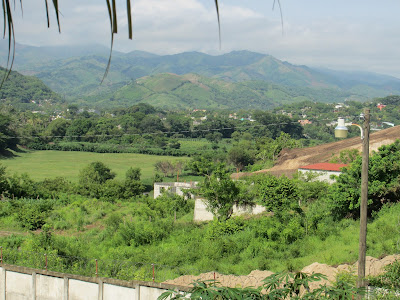There are not words to describe my morning. We made bean tortas and rice milk and visited a village that is located in a garbage dump. A dump. I've read about people who live and scavenge in dumps, but never thought I'd see it. It is beyond heartbreaking and was extremely difficult to see.
It is a very organized system. We could see people's work areas where they sorted their garbage, and we were told that there is a strong honor system and people do not take one another's findings.
We worked with a high school youth group who had collected clothing and shoes to distribute. We served over 100 people.
While a piece of clothing will not change someone's life and a sandwich will not sustain a child for a week, it is a way for H.I.M. to build relationships with the people in the village so that they can then bring mobile medical clinics to them. In fact, while we were there, a woman brought her son to us to ask for advice as he had sustained a femur fracture and was still having pain.
The PT group opened a mobile physical therapy clinic in Pueblo Modelo from 11:00 - 3:00. The people there are actually as impoverished as the people who live at the dump. They just got running water this year. Houses are constructed of a combination of clay bricks, corrugated metal, boxes, and blankets or sheets. There were no floors. I was able to enter a home to borrow a bench. The woman there was cooking over a clay oven with an open fire. We treated about 30 patients and saw everything from kids with mild to severe cerebral palsy to ankle sprains to a woman with an upper extremity prosthesis to a man with knee pain from muscle weakness following a femur fracture to a man with rib pain following a fall from a roof to a woman with nerve damage from a machete wound. Quite a range! The OT group gave a half-day course on working with autistic children to parents and educators in another town.
Making sandwiches
Serving sandwiches
Some of the PT students playing soccer with kids. Note the girl with bare feet. Imagine what she could step on in the trash.
This is Eduardo. He is 8 years old. Evan's age. He is smaller than Nathan. I cannot write more about him without tears. It is not fair.
This picture is courtesy one of the students.
Most of the houses were at the edge of the dump. If you look closely on the right of this picture, you will see two houses that were actually right in the middle of the dump. There were others, too.
Women scavenging for anything that they can sell (metal, glass, etc.)
This is someone's work space.
A home in Pueblo Modelo. Note how one wall is made from hanging material.
Betio is an 8 year old boy with Duchenne Muscular Dystrophy, a neurological disorder characterized by progressive muscular degeneration and weakness. He was able to walk until he fell from a roof into a fire. He has massive scars from the burns and subsequent skin grafts. His wheelchair does not have a cushion and is too big for him and has no foot rests so he couldn't put his feet over the edge. He has severe hip and knee flexion contractures from sitting in the wheelchair like he is in this picture.
My students worked on decreasing some of the contractures.
Then they rigged his wheelchair so that he could get his legs over the side and have a foot rest. It's not perfect, but will hopefully prevent further contractions, which would make it very difficult for his family to care for him. Betio has an older brother with Duchenne Muscular Dystrophy. Life expectancy for a boy in a developing country (without cardiac and respiratory care) is around 14. So much pain for one family. The high school youth group that is down here is working on a house that H.I.M. is building for the family. Betio came to the clinic with his friends because his parents were helping build the house.
Leah, an occupational therapist, and I talking to a little girl at the autism course.




















































